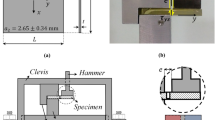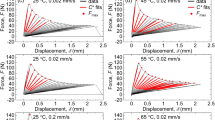Abstract
The paper describes some extensions of four-point bending tests for determining the interfacial fracture toughness \(\Gamma \), in both steady-state and transient regimes, as a function of the fracture mode mixity. Two sets of multimaterial systems were studied: (i) Aluminum alloy (ASTM 2017)/epoxy/PMMA polymer and, (ii) Aluminum alloy (ASTM 2017)/stainless steel (ASTM 301) obtained by bonding and thermal spray coating techniques respectively. The interfacial fracture toughness was investigated by means of analytical and Finite Element Analysis using ABAQUS software. The numerical trend solution of both interfacial fracture toughnesses as function of crack length, and friction coefficient has been obtained and compared to an analytical one. We will propose a method on (i) how both reversed notch position in multimaterial systems and crack delamination beyond the inner loading points (transient regime) are explored to extend the measurement of interfacial fracture toughness, (ii) how the numerical analysis is used to determine the interfacial fracture toughness through an experimental compliance measurement in transient regime, and (iii) we attempt to reveal why the interfacial toughness has strong phase angle dependence.










Similar content being viewed by others
References
ABAQUS (2014) Abaqus 6.14 online documentation. Dassault Systèmes, Providence
Becker TL Jr, McNaney JM, Cannon RM, Ritchie RO (1997) Limitations on the use of the mixed-mode delaminating beam test specimen: effects of the size of the region of \(K\)-dominance. Mech Mater 25(4):291–308
Begley M, Hutchinson J (2017) The mechanics and reliability of films, multilayers and coatings. Cambridge University Press, Cambridge. https://doi.org/10.1017/9781316443606
Budiansky B, Amazigo JC, Evans AG (1988) Small-scale crack bridging and the fracture toughness of particle-reinforced ceramics. J Mech Phys Solids 36:167
Charalambides PG, Lund J, Evans AG, McMeeking RM (1989) A test specimen for determining fracture resistance of bimaterial interfaces. J Appl Mech 56:77–82
Charalambides PG, Cao HC, Lund J, Evans AG (1990) Development of test method for measuring the mixed mode fracture resistance of bimaterial interface. Mech Mater 8:269–283
Cherepanov GP (1979) Mechanics of brittle fracture. Mc-Graw Hill, New York
Clarke DR, Levi CG (2003) Materials design for the next generation thermal barrier coatings. Annu Rev Mater Res 33(1):383–417
Comte C, von Stebut J (2002) Microprobe-type measurement of Young’s modulus and Poisson coefficient by means of depth sensing indentation and acoustic microscopy. Surf Coat Technol 154(1):42–48
Dauskardt R, Lane M, Ma Q, Krishna N (1998) Adhesion and debonding dissimilar materials. Eng Fract Mech 59(6):725–735
Dollhofer J, Beckert W, Lauke B, Schneider K (2000) Fracture mechanical characterisation of mixed-mode toughness of thermoplast/glass interfaces. Comput Mater Sci 19(1–4):223–228
Evans AG, Hutchinson JW (1989) Effects of non-planarity on the mixed mode fracture resistance of bimaterial interfaces. Acta Metall 37(3):909–916
Evans AG, Ruhle M, Dalgleish BJ, Charalambides PG (1990) The fracture energy of bimaterial interfaces. Mater Sci Eng A 126:53–64
Gan Z, Mhaisalkar SG, Chen Z, Zhang S, Chen Z, Prasad K (2005) Study of interfacial adhesion energy of multilayered ULSI thin film structures using four-point bending test. Surf Coat Technol 198:85–89
Harper CA (2002) Handbook of plastics, elastomers, and composites, 4th edn. McGraw-Hill, New York (ISBN: 9780071384766)
Hattali ML, Valette S, Ropital F, Mesrati N, Tréheux D (2009) Study of SiC-nickel alloy bonding for high temperature applications. J Eur Ceram Soc 29:813–819
Hattali ML, Valette S, Ropital F, Mesrati N, Tréheux D (2010) Calculation and experimental determinations of the residual stress distribution in alumina-Ni-alumina and alumina-Ni-nickel alloy systems. J Mater Sci 45:4133–4140. https://doi.org/10.1007/s10853-010-4502-8
Hattali ML, Valette S, Ropital F, Mesrati N, Tréheux D (2012) Interfacial behavior on Al2O3/HAYNES\(\textregistered 214^{{\rm TM}}\) joints fabricated by solid state bonding technique with Ni or Cu-Ni-Cu interlayers. J Eur Ceram Soc 32:2253–2265
Hofinger I, Oechsner M, Bahr HA, Swain MV (1998) Modified four-point bending specimen for determining the interface fracture energy for thin, brittle layers. Int J Fract 92:213–220
Hutchinson JW, Suo Z (1992) Mixed mode cracking in layered materials. Adv Appl Mech 29:63–89
Ikeda T, Miyazaki N, Soda T (1998) Mixed mode fracture criterion of interface crack between dissimilar materials. Eng Fract Mech 59(6):725–735
Liechti KM, Chai YS (1992) Asymmetric shielding in interfacial fracture under in-plane shear. J Appl Mech 59(2):295–304
Matos PPL, McMeeking RM, Charalambides PG, Drory MD (1989) A method for calculating stress intensities in bimaterial interfaces. Int J Fract 40:235–254
Odowd NP, Shih CE, Stout MG (1992) Test geometries for measuring interfacial fracture-toughness. Int J Solids Struct 29(5):571–589
Ranjbar-Far M, Absi J, Mariaux G (2012) Finite element modeling of the different failure mechanisms of a plasma sprayed thermal barrier coatings system. J Therm Spray Technol 21(6):1234–44
Rice JR (1988) Elastic fracture mechanics concepts for interfacial cracks. ASME J Appl Mech 55:98–103
Rice JR, Sih GC (1965) Plane problems of cracks in dissimilar media. ASME J Appl Mech 32(2):418–423
Rice JR, Suo Z, Wang J-S (1990) Mechanics and thermodynamics of brittle interfacial failure in bimaterial systems. In: Ruhle M et al (eds) Acta-scripta metallurgica proceedings series. Pergamon Press, London, pp 269–294
Richards BT, Sehr S, De Francqueville F, Begley MR, Wadley HN (2016) Fracture mechanisms of ytterbium monosilicate environmental barrier coatings during cyclic thermal exposure. Acta Mater 103:448–60
Sadki A, Hattali ML, Bradai MA, Younes R, Mesrati N (2016) Characterization and modeling of the mechanical behavior of aeronautical alloy based composite. Univ J Chem 4(1):10–19. https://doi.org/10.13189/ujc.2016.040102
Suo ZG, Hutchinson JW (1990) Interface crack between 2 elastic layers. Int J Fract 43(1):1–18
Swadener JG, Liechti KM, de Lozanne AL (1999) The intrinsic toughness and adhesion mechanisms of a glass/epoxy interface. J Mech Phys Solids 47(2):223–258
Toya M (1992) On mode I and mode II energy release rates of interface crack. Int J Fract 56:345–352
Wang J-S, Suo Z (1990) Experimental determination of interfacial toughness curves using Brazil-nut sandwiches. Acta Mater 38(7):1279–1290
Wu C, Gowrishankar S, Huang R, Liechti KM (2016) On determining mixed-mode traction-separation relations for interfaces. Int J Fract 202(1):1–19
Yang W, Sherman VR, Gludovatz B, Schaible E, Stewart P, Ritchie RO, Meyers MA (2015) On the tear resistance of skin. Nat Commun 6:6649
Yuuki R, Liu J-Q, Xu J-Q, Ohira T, Ono T (1994) Mixed mode fracture criteria for an interface crack. Eng Fract Mech 47(3):367–377
Zeng Z, Sakoda N, Tajiri T (2006) Corrosion behavior of wire-arc-sprayed stainless steel coating on mild steel. J Therm Spray Technol 15:431–437
Acknowledgements
The first author M.E.M. Zebar was supported by Algerian Ministry of Higher Education and Scientific Research (MESRS) under priority program. The authors would like to thank Lionel Auffray and Alban Aubertin for technical support. We also thank Svetlana Terekhina (ENSAM, LAMPA, Angers), for fruitful discussions and use of Abaqus license.
Funding
The author(s) disclosed receipt of the following financial support for the research, authorship, and/or publication of this article: This study was supported by the French-Algerian collaboration project and financed by Algerian Ministry of Higher Education and Scientific Research (MESRS), Grant Number 595 PNE .
Author information
Authors and Affiliations
Corresponding author
Ethics declarations
Conflict of interest
The author(s) declared no potential conflict of interest with respect to the research, authorship, and/or publication of this article.
Additional information
Publisher's Note
Springer Nature remains neutral with regard to jurisdictional claims in published maps and institutional affiliations.
Rights and permissions
About this article
Cite this article
Zebar, M.E.M., Hattali, M.L. & Mesrati, N. Interfacial fracture toughness measurement in both steady state and transient regimes using four-point bending test. Int J Fract 222, 123–135 (2020). https://doi.org/10.1007/s10704-020-00437-3
Received:
Accepted:
Published:
Issue Date:
DOI: https://doi.org/10.1007/s10704-020-00437-3




